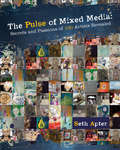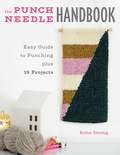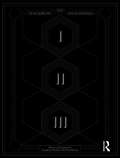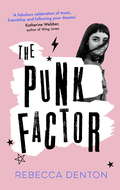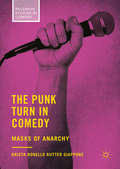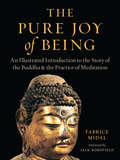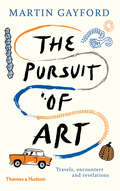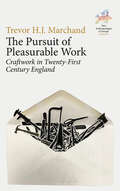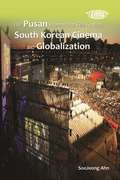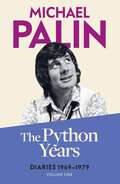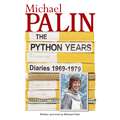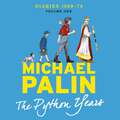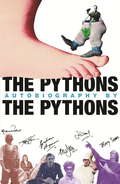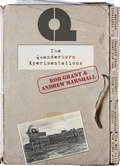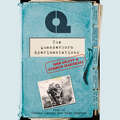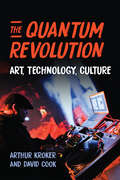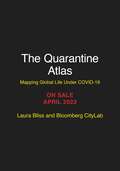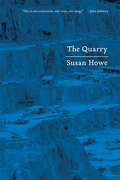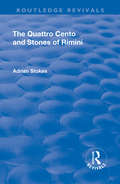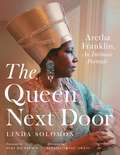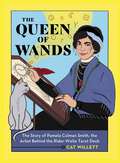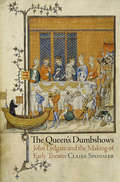- Table View
- List View
The Pulse of Mixed Media: Secrets and Passions of 100 Artists Revealed
by Seth ApterListen closely...can you hear it? Can you hear the voices? Thoughts, insights, confessions from the creative community sharing ideas, trading secrets, venting frustrations; asking and answering questions such as, "What color rarely shows up in your work?" or "How do you express vulnerability in you art?" Or "What is one current trend that you wish would go away?" As artists, we are curious by nature and there is a longing to see inside the hearts and minds of artistic souls of our own kind. That is the beat of our lives-the Pulse of Mixed Media! In this book-a complex survey of artists around the globe-there is much for you to discover: Visual insights: Many questions are answered not only in words, but often through visual art, and include self-portraits from 31 spotlight artists such as Pam Carriker, Danny Gregory and Judy Wise. A diverse sampling of provocative questions: Over 100 artists share their thoughts on everything from color, media and tools, to emotions, secrets and self-revelations Insightful sidebar statistics: Data from thousands of participants collected through polls on the author's blog reveal a remarkable analysis of the creative community at large Indulge your inner voyeur and soak up some inspiration with The Pulse of Mixed Media today!
The Punch Needle Handbook: Easy Guide to Punching plus 19 Projects
by Rohn StrongA craft richly steeped in history and tradition, punch needle is changing the global craft landscape so quickly, it&’s hard to miss. While many crafts take a whole lot of time and effort to master, you can pick up a punch needle and complete a project in less than an hour, with no prior skill needed. It requires just one easy-to-use tool, a background fabric, an embroidery hoop or frame, and yarn. Punched pieces make excellent wall hangings, pillows, ornaments, stool covers, chair cushions, purses/pouches, baby play mats, and much more! If you can imagine it – you can do it.Simple and easy, punch needle is an approach to creating personal and home décor projects that just require you know how to hold a pen. It&’s like paint by number…with yarn!
The Punchdrunk Encyclopaedia
by Josephine MachonThe Punchdrunk Encyclopaedia is the definitive book on the company’s work to date, marking eighteen years of Punchdrunk’s existence. It provides the first full-scale, historical account of one of the world’s foremost immersive theatre companies, drawn from unrivalled access to the collective memory and archives of their core creative team. The playful encyclopaedic format, much like a Punchdrunk masked show, invites readers to create their own journey through the ideas, aesthetics, contexts, and practices that underpin Punchdrunk’s work. Interjections from Felix Barrett, Stephen Dobbie, Maxine Doyle, Peter Higgin, Beatrice Minns, Colin Nightingale and Livi Vaughan, among others, fill out the picture with in-depth reflections. Charting Punchdrunk’s rise from the fringe to the mainstream, this encyclopaedia records the founding principles and mission of the company, documenting its evolving creative process and operational structures. It has been compiled to be useful to scholars and students from a variety of backgrounds and disciplines, from secondary level through to doctoral research, and is intended for those with a fascination for theatre in general and immersive work in particular. Ultimately it is written for those who have dared to come play with Punchdrunk across the years. It is also offered to the curious; those adventurers ready and waiting to be immersed in Punchdrunk worlds.
The Punk Factor (This Beats Perfect #3)
by Rebecca Denton'THE PUNK FACTOR is a kick ass story that will grab your heart in a fierce punk rock grip and not let go. I loved it!' Jennifer Mathieu, author of MOXIESeventeen-year-old Frankie is obsessed with what everyone else is thinking. She can keep up with the chat - from feminism to tattoos - but when it comes to her own ideas, it's not so easy to hide her lack of confidence. But there is one personal obsession she can't deny - her art student drop-out ex boyfriend Doc. With the help of her best friend, Haruna, Frankie forms a punk rock girl band to attract his attention. She's got it all sorted; the Instagram page is live, the handmade posters are everywhere, and the band even has a first gig lined up (even if they are playing to a handful of retired bingo fans). But in her efforts to make the band a success and get Doc to notice her, Frankie starts to care less about what Doc thinks and more about how much she loves making very loud music. She finally feels a glimpse of who she can be, independent of anyone else. Then one day, Doc decides he is going to win her back . . . Punk is nothing without the freedom to be exactly who you want. But what if you're not sure who that is yet? Can you make your own noise when everyone else seems so much louder than you?'Punk rock is just another word for freedom' - Patti Smith
The Punk Turn in Comedy: Masks Of Anarchy (Palgrave Studies in Comedy)
by Krista Bonello Rutter GiapponeThis book examines the interconnections between punk and alternative comedy (altcom). It explores how punk’s tendency towards humour and parody influenced the trajectory taken by altcom in the UK, and the punk strategies introduced when altcom sought self-definition against dominant established trends. The Punk Turn in Comedy considers the early promise of punk-comedy convergence in Peter Cook and Dudley Moore’s ‘Derek and Clive’, and discusses punk and altcom’s attitudes towards dominant traditions. The chapters demonstrate how punk and altcom sought a direct approach for critique, one that rejected innuendo, while embracing the ‘amateur’ in style and experimenting with audience-performer interaction. Giappone argues that altcom tended to be more consistently politicised than punk, with a renewed emphasis on responsibility. The book is a timely exploration of the ‘punk turn’ in comedy history, and will speak to scholars of both comedy and punk studies.
The Pure Joy of Being: An Illustrated Introduction to the Story of the Buddha and the Practice ofof Meditation
by Jack Kornfield Fabrice MidalAn illustrated introduction to the history of Buddhism through teachings on its relevance today and simple meditation practices.There is only one moment in time when it is essential to awaken. That moment is now. —Buddha The art of Buddhism beautifully depicts enlightened beings who demonstrate the practice of meditation yet, while deeply inspiring, art alone cannot teach one to meditate. In The Pure Joy of Being Fabrice Midal brings together traditional Buddhist art with enlightening text as a way to teach the tradition and practice of meditation. Filled with images of bodhisattvas and awakened beings who illustrate the possibility of freedom, alongside practical instruction, advice, and meditations for the everyday situations we face on a daily basis, this book is an accessible introduction to meditation and the wisdom of the Buddha’s teachings. To meditate is to remain in the present moment with attention and benevolence, to remove the desire to manage everything, and to open yourself up to life and all that is possible. It’s as simple as that. And yet, meditating is not easy. What is true happiness? How can we overcome difficulties in life with courage? Can meditation help in today’s world? The Pure Joy of Being teaches that the goal of meditation is to turn us into beings that are more human, and capable of thinking, feeling, and loving better. It offers contemporary practices to set us on this path.
The Pursuit of Art: Travels, Encounters And Revelations
by Martin GayfordOne of our leading art critics and writers, Martin Gayford, recounts his travels and meetings with the world’s greatest artists. In the course of a career thinking and writing about art, critic Martin Gayford has traveled all over the world both to see works of art and to meet artists. Gayford’s journeys, often to fairly inaccessible places, involve frustrations and complications, but also serendipitous encounters and outcomes, which he makes as much a part of the story as the final destination. In chapters that are by turns humorous, intriguing, and stimulating, Gayford takes us to places as varied as Brancusi’s Endless Column in Romania; prehistoric caves in France; the museum island of Naoshima in Japan; the Judd Foundation in Marfa, Texas; and an exhibition of Roni Horn’s work in Iceland. Interwoven with these tales are journeys to meet artists—Henri Cartier-Bresson in Paris, Marina Abramovic´ in Venice, Robert Rauschenberg in New York—and travels with artists, such as a trip to Beijing with Gilbert & George. These encounters not only provide fascinating insights into the way artists approach and think about their art, but reveal the importance of their personal environments. A perceptive, amusing, and knowledgeable companion, in The Pursuit of Art Gayford takes readers on a tour of art that is immensely entertaining, informative, and eminently readable.
The Pursuit of Pleasurable Work: Craftwork in Twenty-First Century England (New Anthropologies of Europe: Perspectives and Provocations #4)
by Trevor H. J. MarchandAgainst the backdrop of an alienating, technologizing and ever-accelerating world of material production, this book tells an intimate story: one about a community of woodworkers training at an historic institution in London’s East End during the present ‘renaissance of craftsmanship’. The animated and scholarly accounts of learning, achievement and challenges reveal the deep human desire to create with our hands, the persistent longing to find meaningful work, and the struggle to realise dreams. In its penetrating explorations of the nature of embodied skill, the book champions greater appreciation for the dexterity, ingenuity and intelligence that lie at the heart of craftwork.
The Pursuit of Pleasurable Work: Craftwork in Twenty-First Century England (New Anthropologies of Europe: Perspectives and Provocations #4)
by Trevor H. J. MarchandAgainst the backdrop of an alienating, technologizing and ever-accelerating world of material production, this book tells an intimate story: one about a community of woodworkers training at an historic institution in London’s East End during the present ‘renaissance of craftsmanship’. The animated and scholarly accounts of learning, achievement and challenges reveal the deep human desire to create with our hands, the persistent longing to find meaningful work, and the struggle to realise dreams. In its penetrating explorations of the nature of embodied skill, the book champions greater appreciation for the dexterity, ingenuity and intelligence that lie at the heart of craftwork.
The Pusan International Film Festival, South Korean Cinema and Globalization
by Soojeong AhnThis book provides a political and cultural exploration of the Pusan International Film Festival in South Korea since its inception in 1996. By paying a particular attention to the organizers' use of an Asian regionalization strategy, SooJeong Ahn reveals how the festival staked out a unique and influential position within a rapidly changing global landscape. Very little primary empirical research has been conducted to date on non-Western film festivals, though PIFF and Tokyo and Hong Kong have swiftly grown more exciting and influential as testing grounds for global cinema innovations. The initiation, development and growth of PIFF should be understood as resulting from productive tensions in the festival's efforts to serve local, regional and national constituencies. The book also reflects the complexities of rapid transformation in the South Korean film industry as it has reached out to the global market since the late 1990s. SooJeong Ahn worked for the Pusan International Film Festival between 1998 and 2002 and has completed a Ph. D. on film festivals at the University of Nottingham. Her recent publications include "Re-imagining the Past: Programming South Korean Retrospectives at PIFF," in Film International (Vol. 6, 2008), "Placing South Korean Cinema into Pusan International Film Festival: Programming Strategy in the Global/Local Context," in What a Difference a Region Makes: Cultural Studies and Cultural Industries in North-East Asia (2009); "Re-mapping Asian Cinema: The Tenth Anniversary of PIFF in 2005" in Cinemas, Identities and Beyond (2010). "In only a decade, the Pusan International Film Festival has gone from its first edition to becoming not only the leading film festival in East Asia, but also one of the world's most important. SooJeong Ahn tells this exciting story for the first time in her groundbreaking book. Her detailed analysis of the reasons for PIFF's success and the direction it has taken is full of fascinating insight and pioneers a new direction in East Asian Cinema Studies. " -- Chris Berry, Goldsmiths, University of London "Ahn's work on the Pusan International Film Festival is the first and the definitive scholarly monograph appearing in English on this key film festival in the East Asian region. With hands-on knowledge and through extensive interviews, Ahn illuminates the dynamics of the national, the regional and the global. Like the great films shown at the festival, this book is not to be missed!"-- Jinhee Choi, King's College London
The Python Years: Diaries 1969-1979 Volume One
by Michael PalinMichael Palin's bestselling diaries before, during and after Monty Python.Michael Palin's diaries begin when he was newly married and struggling to make a name for himself in the world of television comedy. But Monty Python was just around the corner . . .Enjoying an unlikely cult status early on, the Pythons then proceeded to tour the USA and Canada. As their popularity grew, so Palin relates how the group went their separate ways, later to re-form for stage shows and the celebrated films THE HOLY GRAIL and LIFE OF BRIAN. Living through the three-day week and the miners strike, and all the trials of a peripatetic life are also essential ingredients of these perceptive and funny diaries.
The Python Years: Diaries 1969-1979 Volume One
by Michael PalinMichael Palin's diaries begin when he was newly married and struggling to make a name for himself in the world of television comedy. But Monty Python was just around the corner . . .Enjoying an unlikely cult status early on, the Pythons then proceeded to tour the USA and Canada. As their popularity grew, so Palin relates how the group went their separate ways, later to re-form for stage shows and the celebrated films THE HOLY GRAIL and LIFE OF BRIAN. Living through the three-day week and the miners strike, and all the trials of a peripatetic life are also essential ingredients of these perceptive and funny diaries.Read by Michael Palin(p) 2006 Orion Publishing Group
The Python Years: Diaries 1969-1979 Volume One
by Michael PalinMichael Palin's bestselling diaries before, during and after Monty Python.Michael Palin's diaries begin when he was newly married and struggling to make a name for himself in the world of television comedy. But Monty Python was just around the corner . . .Enjoying an unlikely cult status early on, the Pythons then proceeded to tour the USA and Canada. As their popularity grew, so Palin relates how the group went their separate ways, later to re-form for stage shows and the celebrated films THE HOLY GRAIL and LIFE OF BRIAN. Living through the three-day week and the miners strike, and all the trials of a peripatetic life are also essential ingredients of these perceptive and funny diaries.
The Pythons' Autobiography By The Pythons
by Terry Jones Michael Palin Eric Idle John Cleese Terry Gilliam Graham Chapman (Estate) Bob McCabeThis is the definitive, the official, the most lavish, the completely-different-to-anything-done-before Pythons' autobiography, reissued to coincide with the eagerly-anticipated live shows.Over forty years ago, a group of five Englishmen - and one wayward American - rewrote the rules of comedy. MONTY PYTHON'S FLYING CIRCUS, an unheralded, previously unseen half-hour show of sketches, hilarities, inanities and animations, first appeared on the BBC late one night in 1969. Its impact has been felt on the world ever since. From its humble beginnings, it blossomed into the most influential movement in modern comedy. THE PYTHONS' AUTOBIOGRAPHY BY THE PYTHONS is a unique look at arguably the most important comic team of the modern age, with 64 pages of photographs, many culled from the team's own personal collections, many more seen for the first time. This is the definitive word on all things Pythonesque.
The Quanderhorn Xperimentations
by Rob Grant Andrew MarshallADAPTED BACKWARDS VIA THE FUTURE FROM THE RADIO 4 SERIES BEFORE IT WAS MADE A richer, deeper, more comprehensive exploration of the Quanderhorn phenomenon. With added secrets.England, 1952.A time of peace, regeneration and hope. A Golden Age.Unfortunately, it's been 1952 for the past 65 years.Meet Professor Quanderhorn: a brilliant, maverick scientific genius with absolutely no moral compass. Assisted by a rag-tag crew - his part-insect "son" (reputedly 'a major breakthrough in Artificial Stupidity'), a recovering amnesiac, a brilliant scientist with a half-clockwork brain, and a captured Martian hostage - he'll save the world.Even if he has to destroy it in the process.With his Dangerous Giant Space Laser, Utterly Untested Matter Transfuser Booth and Fleets of Monkey-driven Lorries, he's not afraid to push the boundaries of science to their very limit.And far, far beyond ...
The Quanderhorn Xperimentations
by Rob Grant Andrew MarshallADAPTED BACKWARDS VIA THE FUTURE FROM THE RADIO 4 SERIES BEFORE IT WAS MADE A richer, deeper, more comprehensive exploration of the Quanderhorn phenomenon. With added secrets.England, 1952.A time of peace, regeneration and hope. A Golden Age.Unfortunately, it's been 1952 for the past 65 years.Meet Professor Quanderhorn: a brilliant, maverick scientific genius with absolutely no moral compass. Assisted by a rag-tag crew - his part-insect "son" (reputedly 'a major breakthrough in Artificial Stupidity'), a recovering amnesiac, a brilliant scientist with a half-clockwork brain, and a captured Martian hostage - he'll save the world.Even if he has to destroy it in the process.With his Dangerous Giant Space Laser, Utterly Untested Matter Transfuser Booth and Fleets of Monkey-driven Lorries, he's not afraid to push the boundaries of science to their very limit.And far, far beyond ...
The Quanderhorn Xperimentations
by Rob Grant Andrew MarshallEngland, 1952.Churchill is Prime Minister for the last time. Rationing is still in force. All music sounds like the BBC Radiophonic Workshop. People like living in 1952: it's familiar and reassuring, and Britain knows its place in the world.Few have noticed it's been 1952 for the past 65 years.Meet Professor Quanderhorn; a brilliant, maverick scientific genius who has absolutely no moral compass. With his Dangerous Giant Space Laser, High Rise Farm, Invisible Robot and Fleet of Monkey-driven Lorries, he's not afraid to push the boundaries of science to their very limit.Even when it's clearly insane to keep pushing.Despite the fact he's saved the world from several Martian invasions, the attacks of the Mole People, the Troglodyte Shape-shifters and the Beatniks from Under the Sea, plus countless other sinister phenomena which threatened to rend the very fabric of reality, the Government would like to close him down. Why? Because they're terrified of him. Of his reality-warping experiments, of the mysterious button on his desk which he's constantly threatening to press. Of the unearthly secret locked in his cellar. And yet they're even more terrified it might stop being 1952 and they'll be out of power.Read by Cassie Layton and Ryan Sampson(p) Orion Publishing Group 2018
The Quantum Revolution: Art, Technology, Culture (Digital Futures)
by David Cook Arthur KrokerWe are currently riders of the information storm. AI fascinates us, images mesmerize us, data defines us, algorithms remember us, news bombards us, devices connect us, isolation saddens us. Deeply embedded in digital technology, we are the very first inhabitants of life in the quantum zone. The Quantum Revolution is about life today – its entanglements, creativity, politics, and artistic vision. Arthur Kroker and David Cook explore a new way of thinking drawn directly from the quantum imaginary itself. They explain the quantum revolution as everyday life, where technology moves fast, and where, under cover of the digital devices that connect us, the most sophisticated concepts of technology and science originating in mathematics, astrophysics, and biogenetics have swiftly flooded human consciousness, shaped social behavior, and crafted individual identity. The book discusses the concept of the quantum zone as a new way of understanding digital culture, and presents stories about art, technology, and society, as well as a series of reflections on art as a gateway to understanding the quantum imaginary. Richly illustrated with sixty images of critically engaged photos and artwork, The Quantum Revolution privileges a new way of understanding and seeing politics, society, and culture through the lens of the duality that is the essence of the quantum imaginary.
The Quarantine Atlas: Mapping Global Life Under COVID-19
by Laura Bliss A Bloomberg CityLab ProjectThe Quarantine Atlas is a poignant and deeply human collection of more than 65 homemade maps created by people around the globe that reveal how the coronavirus pandemic has transformed our physical and emotional worlds, in ways both universal and unique. Along with eight original essays, it is a vivid celebration of wayfinding through a crisis that irrevocably altered the way we experience our environment.In April 2020, Bloomberg CityLab journalists Laura Bliss and Jessica Lee Martin asked readers to submit homemade maps of their lives during the coronavirus pandemic. The response was illuminating and inspiring. The 400+ maps and accompanying stories received served as windows into what individuals around the world were experiencing during the crisis and its resonant social consequences. Collectively, these works showed how coronavirus has transformed the places we live, and our relationships to them.In The Quarantine Atlas, Bliss distills these stunning submissions and pairs them with essays by journalists and authors, as well as notes from the original mapmakers. The result is an enduring visual record of this unprecedented moment in human history. It is also a celebration of the act of mapping and the ways maps can help us connect and heal from our shared experience.
The Quarry: Essays
by Susan HoweThe Quarry presents new and pivotal Susan Howe prose pieces. A powerful selection of Susan Howe's key essays, The Quarry moves backward chronologically, from her brand-new "Vagrancy in the Park" (about Wallace Stevens) through essential texts such as "The Disappearance Approach," "Personal Narrative," "Sorting Facts; or, 47 Ways of Looking at Chris Marker," "Frame Structures," and "Where Should the Commander Be" to end with her seminal early art criticism, "The End of Art."
The Quattro Cento and Stones of Rimini: A Different Conception of the Italian Renaissance
by Adrian StokesThis title was first published in 2002. Adrian Stokes was a British painter and writer whose books on art have been allowed to go out of print despite their impact on Modernist culture. This new edition of The Quattro Cento and The Stones of Rimini presents the original texts of 1932 and 1934 and furnishes them with introductions by David Carrier and Stephen Kite that will help readers grasp the structure and significance of what have become Stokes' most widely cited and influential books. Written as parts of an incomplete trilogy, The Quattro Cento and The Stones of Rimini mark a crossroad in the transition from late Victorian to Modernist conceptions of art, especially sculpture and architecture. Stokes continued, even expanded, John Ruskin's and Walter Pater's belief that art is essential to the individual's proper psychological development but wove their teaching into a new aesthetic shaped by his experience of psychoanalysis and recent innovations in literature, dance, and the visual arts. This volume will be of interest to those concerned with art criticism, aesthetics and psychoanalysis, as well as the art and architecture of the Renaissance and Modern periods. Supported by the Henry Moore Foundation in memory of David Sylvester.
The Quay Brothers: Into a Metaphysical Playroom
by Suzanne BuchanThis work is the first thorough analysis of the creative oeuvre of the Quay Brothers. Known for their animation shorts that rely on puppetry, miniatures, and stop-motion techniques, their fiercely idiosyncratic films are fertile fields for Suzanne Buchan's engaging descriptions and provocative insights into the Quays' art-and into the art of independent puppet animation.Buchan's aesthetic investigation stems from extensive access to the Quay Brothers' artistic practices and work, which spans animation and live-action film, stage design and illustration. She also draws on a long acquaintance with them and on interviews with collaborators essential to their productions, as well as archival sources. Discussions of their films' literary origins, space, puppets, montage, and the often-overlooked world of sound and music in animation shed new light on the expressive world that the Quay Brothers generate out of their materials to create the poetic alchemy of their films.At once a biography of the Quays' artistic trajectory and a detailed examination of one of their best-known films, Street of Crocodiles, this book goes further and provides interdisciplinary methodologies and tools for the analysis of animation.
The Queen Next Door: Aretha Franklin, An Intimate Portrait (Painted Turtle)
by Linda Solomon"Aretha was private. I respected this and she trusted me." Linda Solomon met Aretha Franklin in 1983 when she was just beginning her career as a photojournalist and newspaper columnist. Franklin’s brother and business manager arranged for Solomon to capture the singer’s major career events—just as she was coming back home to Detroit from California—while Franklin requested that Solomon document everything else. Everything. And she did just that. What developed over these years of photographing birthday and Christmas parties in her home, annual celebrity galas, private backstage moments during national awards ceremonies, photo shoots with the iconic pink Cadillac, and more was a friendship between two women who grew to enjoy and respect one another. The Queen Next Door: Aretha Franklin, An Intimate Portrait is a book full of firsts as Solomon was invited not only to capture historical events in Aretha’s music career showcasing Detroit but to join in with the Franklin family’s most intimate and cherished moments in her beloved hometown. From performance rehearsals with James Brown to off-camera shenanigans while filming a music video with the Rolling Stones, from her first television special to her first time performing with the Detroit Symphony Orchestra, to her last performance with her sisters at her father’s church and her son’s college graduation celebration. In the book’s afterword, Sabrina Vonne' Owens, Franklin’s niece, honors her aunt, a woman who was an overwhelming supporter of civil rights, women’s rights, and fundraising campaigns that helped to benefit her hometown. There was a time in her career—when Franklin was more in demand than ever before—when she insisted that if someone wanted her to perform, they had to come to Detroit. During this time all of her major concerts, national television specials, music videos, and commercials would happen in Detroit. Aretha Franklin showed her respect for the people in the city who championed her from the very beginning when she started singing as a young girl in the church choir. Franklin used to say, "I am the lady next door when I am not on stage." The Queen Next Door offers fans a personal and unseen look at an extraordinary woman in her most natural moments—both regal and intimate—and highlights her devotion to her family and her hometown Detroit—"forever and ever."
The Queen of Wands: The Story of Pamela Colman Smith, the Artist Behind the Rider-Waite Tarot Deck
by Cat WillettDiscover the life, work, and magic of Pamela Colman Smith, the visionary artist behind the Rider-Waite-Smith Tarot Deck, the most popular and renowned divination deck in the world. With rich imagery, stunning colors, and an iconic place in the realm of divination, the Rider-Waite Tarot is perhaps the best known deck in the world. Seasoned readers and fledgling diviners alike turn to these cards in search of inspiration, understanding, and even a hint at the future. But the story of their origin is less well known, with their brilliant creator's name stripped away from them for decades. Now, for the first time, mystics, art-lovers, and fortune-tellers will uncover the magical story of Pamela Coleman Smith, rendered in full-color illustrations by artist Cat Willett, and inspired by the work of Pamela herself. From a childhood spent between the United Kingdom and Jamaica, to early artistic success in New York, to involvement in the secret occult society Order of the Golden Dawn, Pamela -- or Pixie, as she was known to many -- had a life full of enchanted inspiration and profound hardship. Through it all, her art acted as a guiding force, culminating in her custom illustrations for the deck that would become the Rider-Waite Tarot. Though she received little money and almost no credit for her contributions to the magical realm in her lifetime, Pixie's impact on tarot, divination, and the worlds of mysticism and the arts have reverberated for nearly 150 years, and her story serves as an enchanted spark. Depicted in whimsical, full-color detail, with interludes tying Pamela to the resurgence of modern magic and the world of tarot throughout, this singular work is a must-read for witches, creatives, and activists.
The Queen's Dumbshows
by Claire SponslerNo medieval writer reveals more about early English drama than John Lydgate, Claire Sponsler contends. Best known for his enormously long narrative poems The Fall of Princes and The Troy Book, Lydgate also wrote numerous verses related to theatrical performances and ceremonies. This rich yet understudied body of material includes mummings for London guildsmen and sheriffs, texts for wall hangings that combined pictures and poetry, a Corpus Christi procession, and entertainments for the young Henry VI and his mother.In The Queen's Dumbshows, Sponsler reclaims these writings to reveal what they have to tell us about performance practices in the late Middle Ages. Placing theatricality at the hub of fifteenth-century British culture, she rethinks what constituted drama in the period and explores the relationship between private forms of entertainment, such as household banquets, and more overtly public forms of political theater, such as royal entries and processions. She delineates the intersection of performance with other forms of representation such as feasts, pictorial displays, and tableaux, and parses the connections between the primarily visual and aural modes of performance and the reading of literary texts written on paper or parchment. In doing so, she has written a book of signal importance to scholars of medieval literature and culture, theater history, and visual studies.
